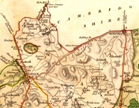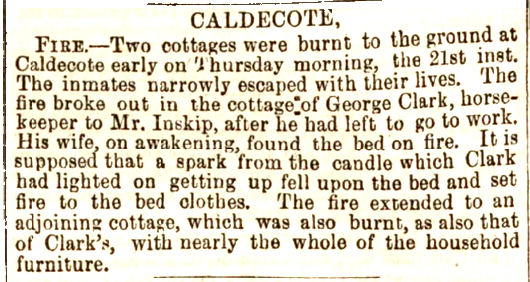|
Caldecote |
CALDECOTE is a parish containing but one farm and eight cottages, on the Beds border of the county, about 3 miles nort-north-east from Baldock station on the Hitchin and Cambridge branch of the Great Northern Railway, 8 miles north-east from Hitchin and 40 from London, in the Northern division of the county, Odsey hundred, Hitchin petty sessional division, union and county court district, and in the rural deanery of Baldock and arch-deaconry and diocese of St Albans. The church of St Mary Magdalen is an ancient structure of rubble in the Perpendicular style, consisting of chancel, nave of one bay, south porch and a western tower containing one bell: there a memorials to Francis Squire, d. 1732, James Flint, d. 1763, and Elizabeth, his wife, d. 1765: the font, octagonal and enriched, dates from about 1840: in the porch is a stoup for holy water, with a very richly worked canopy: the church now affords 53 sittings. The register dates from the year 1726. The living is a rectory, net yearly value £63, in the gift of T. W. H. Inskip esq, K.C. and held since 1911 by the Rev. William Ernest Parker, who is also vicar of and resides at Newnham. William Dawe esq. is the sole landowner. The soil and subsoil, various. The chief crops are wheat, barley and root crops generally. The area is 326 acres; rateable value, £322; the population in 1911 was 35. Letters through Baldock, Herts, arrive at 7.30 a.m. (& 11 a.m. to callers at Newnham). Stotford, Beds is the nearest money order & telegraph office. The nearest post office is Newnham, three-quarters of a mile; letters dispatched 12.20 & 8.30 p.m. The children of this parish attend the school at Newnham. Dawe William, farmer & landowner Kelly's Directory for Hertfordshire, 1914
The church is now in the care of the charity "Friends of Friendless Churches" (www.friendsoffriendlesschurches.org.uk) and there are further picture of the church on their web site. A local group has been set up called "Caldecote Church Friends" (www.caldecotechurchfriends.org.uk) and their web site has further information on the church, it history, and the work they are doing to raise funds to support the church. |
Adjacent Parishes: Ashwell, Hinxworth, Newnham, Radwell | |||||||||
| It is in Odsey Hundred and the Hitchin Union | ||||||||||
 Area maps |
||||||||||
| GENUKI | ||||||||||
| Wikipedia | ||||||||||
|
||||||||||
| If you have a relevant question why not Ask Chris | ||||||||||
|
If you know of other books, websites, etc, relating to this place, please tell me. |
||||||||||
 |
Fire at Codicote Herts Mercury 30th January, 1858
The 1861 census shows Thomas Inskip (50) was a farmer of 424 acres employing 6 men and 7 boys. George Clark (31) was a farm labourer living nearby with his wife and young family. |
|
EXCAVATIONS AT THE DESERTED MEDIEVAL VILLAGE OF CALDECOTE, HERTFORDSHIRE - AN INTERIM REPORT by Guy Beresford CALDECOTE (Grid Ref. TL 237385) the site of a deserted medieval village lies some 2½ miles north-northwest of Baldock on a chalky subsoil approximately 180ft above sea level. The position of the settlement was clearly defined by the church, the manor and the earth works of the peasant crofts. Five seasons of excavations were arranged by the Medieval Village Research Group and the Department of the Environment to examine the medieval remains of the crofts, the rectory site and the manor before the earthworks were levelled and ploughed. ... ... Caldecote, one of the smallest parishes in Hertfordshire, is only 325 acres in extent and could never have supported a large population. In 1087 the Domesday records that there was a priest, nine villeins and four cottars. The excavations revealed that during the 12th and 13th centuries there were approximately nine crofts lying to the north of the church and possibly three 'Others close to the north west boundary of the present manor garden. The population had declined by the early 14th century: no subsidy was paid in 1428 indicating that there were less than ten householders. The excavation has demonstrated that after the manor was granted to the Priory the lands of the peasantry were gradually amalgamated: by the early 14th century the manor comprised the manor farm, the glebe and four other farms. During the late 15th and early 16th centuries the farms were gradually rebuilt away from the centre of the village. This pattern of settlement was to persist until the early 18th century when the manor took in hand all the lands except those of the Glebe. Extract from summary of article in Hertfordshire Past, No 4, 1978 |
Caldecote The Development and Desertion of a Hertfordshire Village by Guy Beresford The Society for Medieval Archaeology Monograph 28GENUKI |
| Permanent Link | www.hertfordshire-genealogy.co.uk/links/xxx.htm | |
| January 2013 | Page reformated with new menu |
See also Vital Records
If you know of other books, websites, etc, relating to this place, please tell me.
Updated August 2008